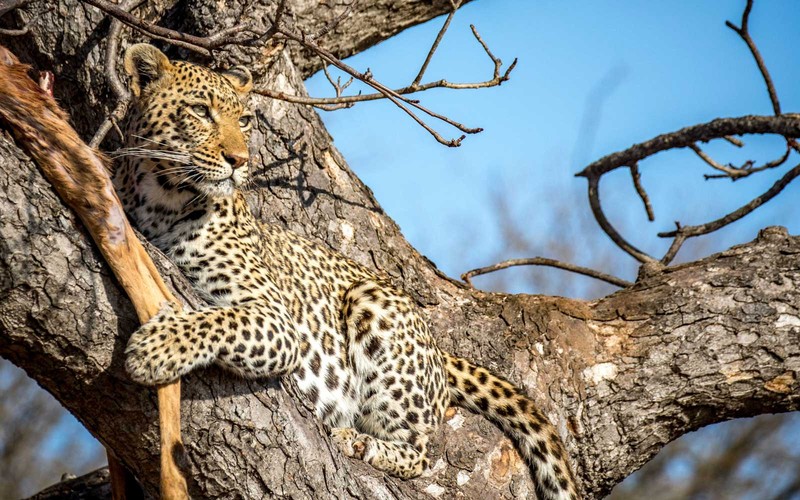The Big Five are fascinating to photograph, but their large size, habitats, and behaviors make it difficult to take pictures of them. There are many ways to view these famous animals, such as on the Big Five Safari in the Kruger, on a guided walking tour, or on a self-drive tour.
African Elephant
The largest land animal, the African elephant, lives in Kruger National Park. They are a social species, living in family groups led by a female. Capturing their interactions can result in powerful, emotional images.
African Buffalo
The African buffalo, or Cape buffalo, is a strong plant-eater living in Kruger National Park. They often move in groups and have a tight connection with each other. Taking photos of them can capture their bond and how they protect their fellow group members.
African Lion
The iconic African lion, known as the continent’s top predator, commonly rests during the daytime. They can often be found in shaded spots or even lounging on trees. To photograph lions, one must exercise patience, as they are most active in the early mornings and late afternoons. Capturing their regal essence emphasizes their special role in Africa’s ecosystem and sheds light on their captivating habits.
African Leopard
The masterful African leopard, an expert in camouflage, often resides in tree branches. Observing and photographing these enigmatic big cats can be tough, but the satisfaction of capturing their grace and allure is valuable. Their amazing ability to blend in with their surroundings shows how versatile these beautiful creatures are in their natural habitat.
African Rhinoceros
You can find rhinos living in different environments within Kruger National Park. However, they are typically more challenging to observe compared to other prominent animals in the park, like the rest of the Big Five. These amazing animals are important to their ecosystems and need to be protected so they can stay alive. Raising awareness about their plight and supporting conservation efforts can help safeguard their future.
Photography Gear and Equipment
When photographing the Big Five, it’s essential to have the right gear to capture stunning images. Here’s a list of recommended equipment for your Kruger safari:
- DSLR or mirrorless camera with a high-resolution sensor.
- Telephoto lens (200mm to 400mm) for capturing close-up images of wildlife without disturbing them.
- Wide-angle lens (16mm to 35mm) for landscape and environmental shots.
- Monopod or tripod for stabilizing your camera during long periods of waiting.
- Extra camera batteries and memory cards.
- Protective camera bag or case to keep your gear safe from dust and moisture.
- Lens cleaning kit to keep your lenses free from dust and smudges.
Best Times and Locations for Wildlife Photography
To increase your chances of capturing the Big Five, it’s essential to know when and where to find them within Kruger National Park.
Best Times
The best time for wildlife photography in Kruger is during the dry season (May to September), as animals tend to congregate around water sources, making them easier to locate and photograph. Additionally, the sparse vegetation during this time provides better visibility and fewer obstructions for photographers.
Best Locations
While the Big Five can be found throughout Kruger National Park, certain areas are known for higher concentrations of specific animals:
- African elephants are commonly found in the central and southern regions of the park.
- African buffaloes are often seen near water sources, such as the Sabie River in the southern region.
- African lions are frequently spotted in the central and southern regions, particularly around the Satara Rest Camp.
- African leopards can be found throughout the park but are more common in the southern region.
- African rhinoceroses are generally more difficult to spot but can be found in the central and southern regions, with the white rhino being more common in the south.
Photography Tips and Techniques
To capture stunning images of the Big Five, consider the following tips and techniques:
- Practice patience and be prepared to wait for the perfect moment. Wildlife photography often requires long periods of waiting for animals to appear or exhibit interesting behaviors.
- Use a fast shutter speed (at least 1/500th of a second) to freeze the motion of animals and ensure sharp images.
- Shoot during the golden hours (early morning and late afternoon) for the most flattering light.
- Look for unique perspectives, such as capturing animals from a low angle or including their environment in the frame.
- Focus on the eyes. Sharp, well-lit eyes draw viewers into the image and create a connection with the subject.
Stay Safe and Act Ethical
- When taking photos of wildlife in Kruger National Park, remember:
- Always follow park rules, keep a safe distance from animals, and stay in allowed areas.
- Don’t bother animals or their homes just for a picture.
- Respect other visitors and their experiences.
Help conservation by sharing photos responsibly and spreading awareness about endangered species.


